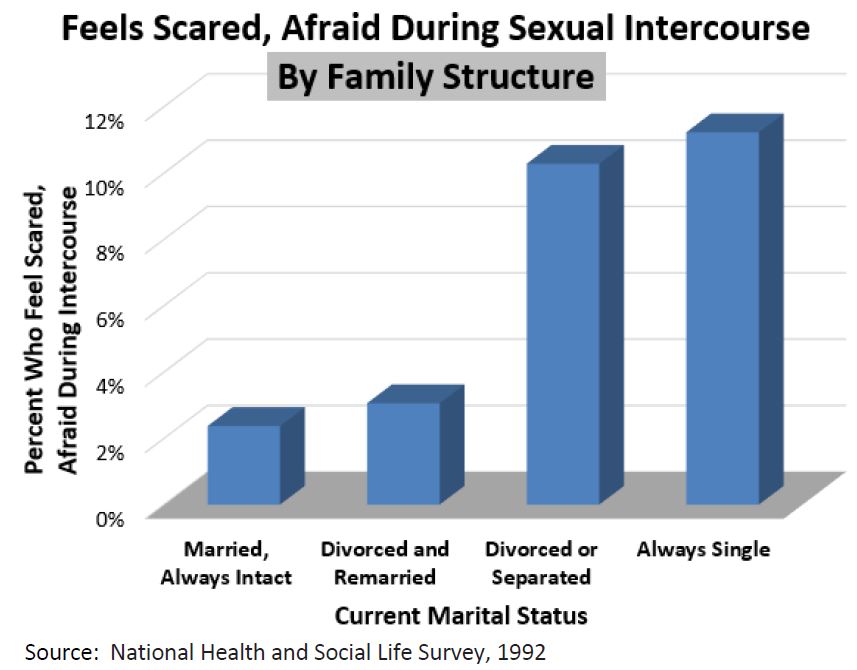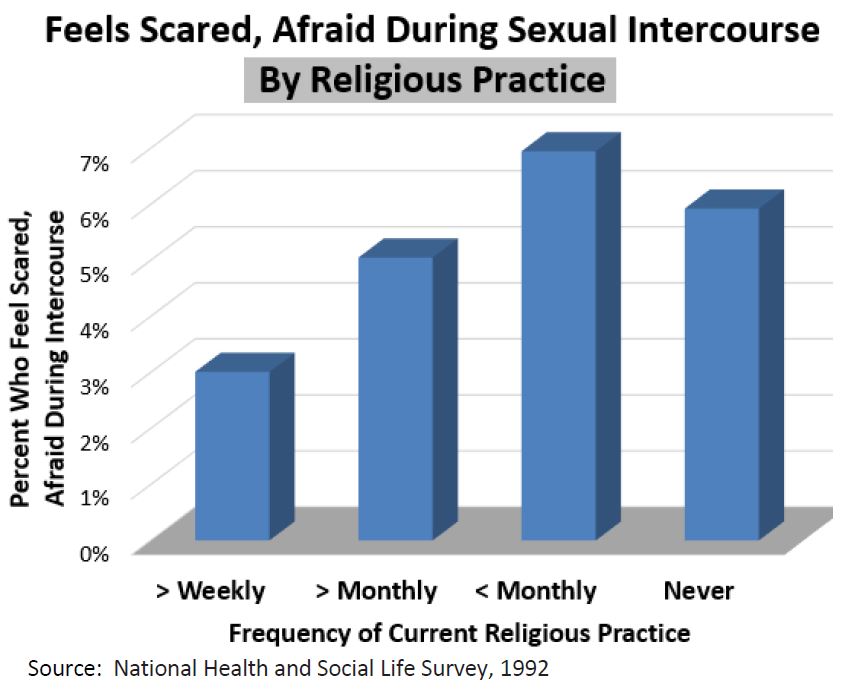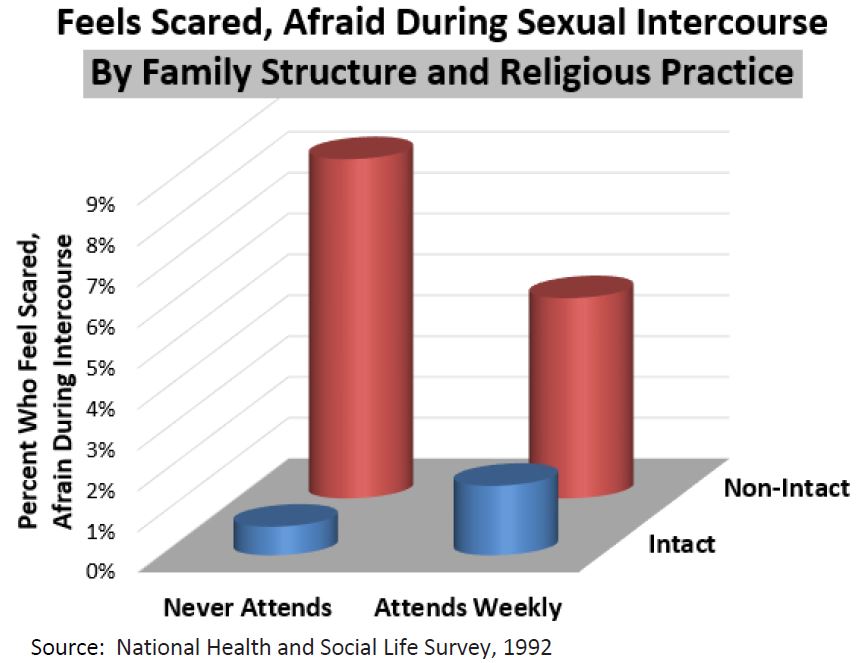Click Here to download “Feels Scared, Afraid During Sexual Intercourse by Family Structure and Religious Practice”
Feels Scared, Afraid During Sexual Intercourse by Family Structure and Religious Practice
The 1992 National Health and Social Life Survey shows that, of adults aged 18 to 59, those in intact marriages and those who worshipped weekly were least likely to report feeling scared or afraid during intercourse with their current sexual partner.
[1]
Family Structure: Those in always-intact marriages were least likely to feel scared or afraid during intercourse with their current sexual partner (2.4 percent), followed by those who were divorced and remarried (3.1 percent). Those who were divorced or separated (10.3 percent) and those who were always single (11.2 percent) were much more likely to feel scared or afraid.
 Religious Practice:
Religious Practice: Those who worshipped weekly (3 percent) were least likely to feel scared or afraid during intercourse with their current sexual partner, followed by those who worshipped less than weekly but at least monthly (5 percent), those who never worshipped (5.9 percent), and those who worshipped less than monthly (6.9 percent).
 Family Structure and Religious Practice Combined:
Family Structure and Religious Practice Combined: Those in intact marriages who never worshipped were least likely to feel scared or afraid during intercourse with their current sexual partner (.7 percent)
[2], followed closely by those in intact marriages who worshipped weekly (1.7 percent). Those in non-intact family structures and singles who worshipped weekly (4.9 percent) were more likely to feel scared or afraid, and those in non-intact family structures and singles who never worshipped (8.3 percent) were even more so.
 Related Insights from Other Studies:
Related Insights from Other Studies: Though the National Health and Social Life Survey included only adults, data from the National Longitudinal Survey of Youth shows those who worship weekly are least likely (14 percent) to have intercourse at or before age 14. Those who worship less than weekly but at least monthly (20 percent), those who worship less than monthly (24 percent), and those who never worship (26 percent) were much more likely to have had intercourse at or before age 14.
[3] Sexual debut at such an early age may contribute to fear during intercourse.
Among unmarried girls who have never had intercourse, those who were adamant about their unlikelihood to engage in premarital intercourse (“adamant virgins”) were very likely (50 percent) to report that religious or moral reservations were their primary reason for abstaining, compared to a very small proportion (2 percent) of virgin girls who did not report that they were very unlikely to engage in premarital sex (“potential nonvirgins”). However, 15 percent of these potential nonvirgins reported that their primary reason for abstaining was fear of pregnancy, compared to only 7 percent of adamant virgins.
[1] These charts draw on data collected by the 1992 National Health and Social Life Survey
[2] This group being the “best” situation is unusual and worth noting because it breaks the standard pattern.
[3] Marriage and Religion Research Institute, “The Benefits of Religious Worship: Positive Outcomes Associated with Weekly Worship,” (2011): 12. Available at
www.marri.us/benefits-religious-worship. Accessed July 3, 2012.]]>
 Religious Practice: Those who worshipped weekly (3 percent) were least likely to feel scared or afraid during intercourse with their current sexual partner, followed by those who worshipped less than weekly but at least monthly (5 percent), those who never worshipped (5.9 percent), and those who worshipped less than monthly (6.9 percent).
Religious Practice: Those who worshipped weekly (3 percent) were least likely to feel scared or afraid during intercourse with their current sexual partner, followed by those who worshipped less than weekly but at least monthly (5 percent), those who never worshipped (5.9 percent), and those who worshipped less than monthly (6.9 percent).
 Family Structure and Religious Practice Combined: Those in intact marriages who never worshipped were least likely to feel scared or afraid during intercourse with their current sexual partner (.7 percent)[2], followed closely by those in intact marriages who worshipped weekly (1.7 percent). Those in non-intact family structures and singles who worshipped weekly (4.9 percent) were more likely to feel scared or afraid, and those in non-intact family structures and singles who never worshipped (8.3 percent) were even more so.
Family Structure and Religious Practice Combined: Those in intact marriages who never worshipped were least likely to feel scared or afraid during intercourse with their current sexual partner (.7 percent)[2], followed closely by those in intact marriages who worshipped weekly (1.7 percent). Those in non-intact family structures and singles who worshipped weekly (4.9 percent) were more likely to feel scared or afraid, and those in non-intact family structures and singles who never worshipped (8.3 percent) were even more so.
 Related Insights from Other Studies: Though the National Health and Social Life Survey included only adults, data from the National Longitudinal Survey of Youth shows those who worship weekly are least likely (14 percent) to have intercourse at or before age 14. Those who worship less than weekly but at least monthly (20 percent), those who worship less than monthly (24 percent), and those who never worship (26 percent) were much more likely to have had intercourse at or before age 14.[3] Sexual debut at such an early age may contribute to fear during intercourse.
Among unmarried girls who have never had intercourse, those who were adamant about their unlikelihood to engage in premarital intercourse (“adamant virgins”) were very likely (50 percent) to report that religious or moral reservations were their primary reason for abstaining, compared to a very small proportion (2 percent) of virgin girls who did not report that they were very unlikely to engage in premarital sex (“potential nonvirgins”). However, 15 percent of these potential nonvirgins reported that their primary reason for abstaining was fear of pregnancy, compared to only 7 percent of adamant virgins.
[1] These charts draw on data collected by the 1992 National Health and Social Life Survey
[2] This group being the “best” situation is unusual and worth noting because it breaks the standard pattern.
[3] Marriage and Religion Research Institute, “The Benefits of Religious Worship: Positive Outcomes Associated with Weekly Worship,” (2011): 12. Available at www.marri.us/benefits-religious-worship. Accessed July 3, 2012.]]>
Related Insights from Other Studies: Though the National Health and Social Life Survey included only adults, data from the National Longitudinal Survey of Youth shows those who worship weekly are least likely (14 percent) to have intercourse at or before age 14. Those who worship less than weekly but at least monthly (20 percent), those who worship less than monthly (24 percent), and those who never worship (26 percent) were much more likely to have had intercourse at or before age 14.[3] Sexual debut at such an early age may contribute to fear during intercourse.
Among unmarried girls who have never had intercourse, those who were adamant about their unlikelihood to engage in premarital intercourse (“adamant virgins”) were very likely (50 percent) to report that religious or moral reservations were their primary reason for abstaining, compared to a very small proportion (2 percent) of virgin girls who did not report that they were very unlikely to engage in premarital sex (“potential nonvirgins”). However, 15 percent of these potential nonvirgins reported that their primary reason for abstaining was fear of pregnancy, compared to only 7 percent of adamant virgins.
[1] These charts draw on data collected by the 1992 National Health and Social Life Survey
[2] This group being the “best” situation is unusual and worth noting because it breaks the standard pattern.
[3] Marriage and Religion Research Institute, “The Benefits of Religious Worship: Positive Outcomes Associated with Weekly Worship,” (2011): 12. Available at www.marri.us/benefits-religious-worship. Accessed July 3, 2012.]]>
